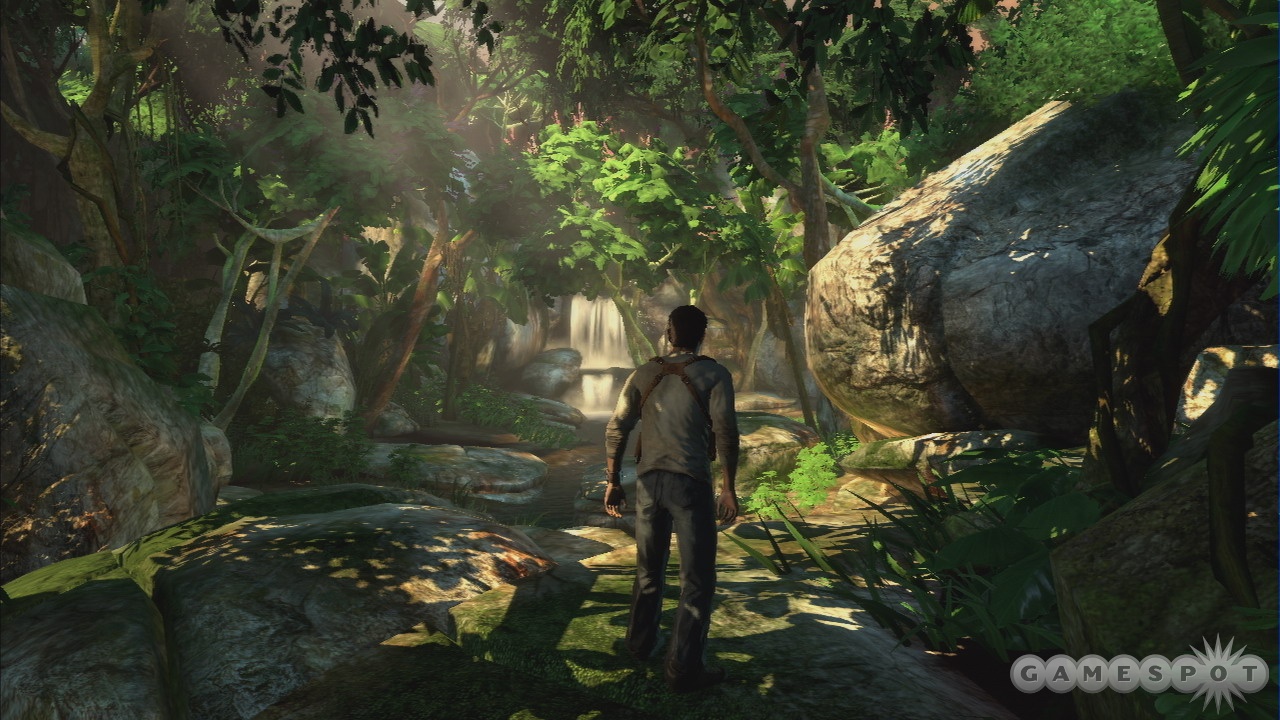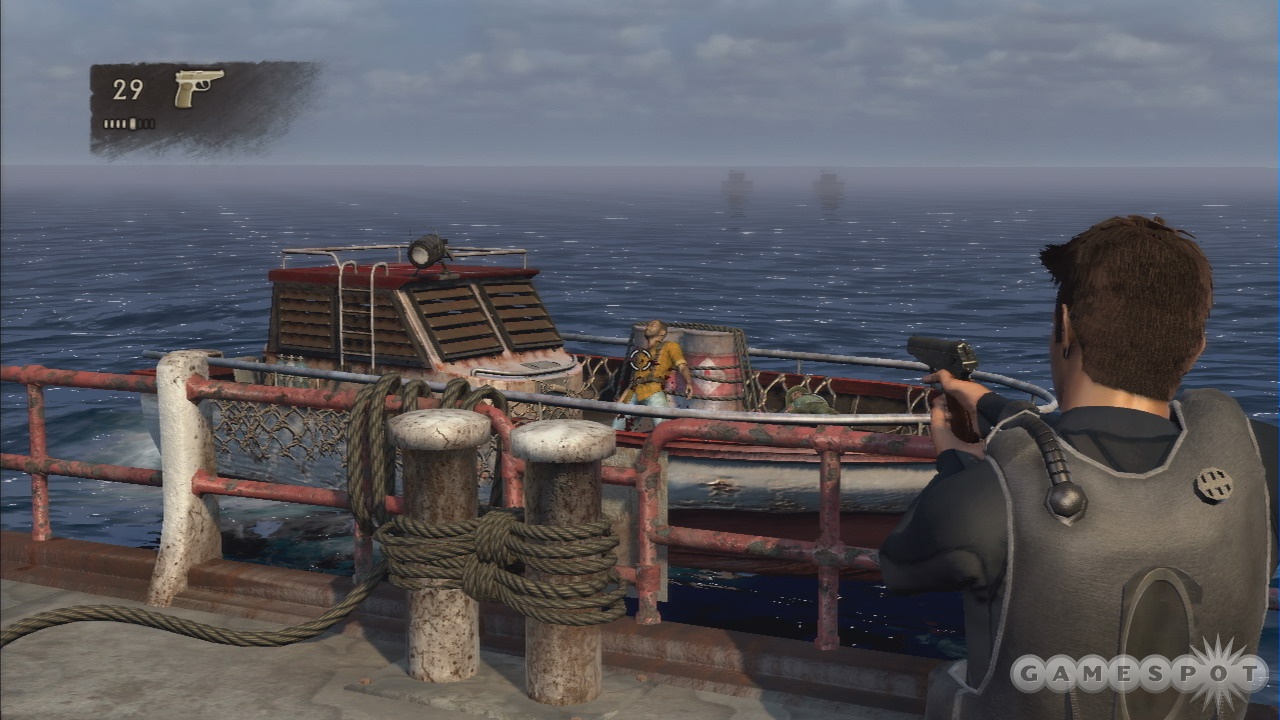Uncharted: Drake's Fortune is not a game about new ideas. The gameplay can and has been summed up as "Tomb Raider meets Gears of War," and the story plays almost like an unfilmed National Treasure script, which is another way of saying that the Indiana Jones influence on the story is palpable. Keep in mind that "derivative" isn't the same as "bad." Developer Naughty Dog has assembled its borrowed parts with great proficiency to create an action adventure game with momentum, one that is filled with exciting set pieces, a real cinematic scope, and some of the most gorgeous visuals you'll see in a game.

That Uncharted: Drake's Fortune is a game that trades in archetypes is apparent throughout the story. You'll play as Nathan Drake, an independent adventurer with a wry sense of humor who claims to be a descendent of Sir Francis Drake. That fact figures prominently in the narrative as you go hunting for an ancient relic believed to be hidden somewhere on an uncharted tropical island. The supporting cast includes your friend Sully, who's a cigar-chomping, affable cad with a taste for trouble, and Elena, a confident TV reporter who splits her time between being your sidekick and your damsel in distress. There are villains as well, including Nathan's dry British counterpart as well as a belligerent pirate captain, though you'll likely find their minions far more threatening. The game attempts to add some twists and turns to the plot, but they never really pan out. Nevertheless, the story generally moves with efficiency, as well as some occasionally snappy dialog.
Even if what's happening during the in-engine cutscenes isn't significant, it always looks great. Much of the game takes place in dense jungle environments and a variety of ancient ruins, which the game renders with a nearly photorealistic level of detail. Plants sway, water trickles, and the textures really look like they've got texture. There are a few moments when the game goes outside its wheelhouse with some murky industrial environments that look flat and drab by comparison, but these sequences are rare.
Nathan himself isn't a particularly flashy-looking character in his dirty gray shirt and jeans, but the subtlety of his animation conveys more about him than any outfit would. He'll do a stumbled half-step when traversing uneven terrain, and you'll see him wince when a bullet gets too close to comfort during a firefight. Likewise, his arms will flail spastically during a big jump, and afterward he'll dangle precariously by one hand on the edge he was aiming for. When he gets into a fistfight, half the time it's surprising he makes it out alive. Even when he's performing seemingly impossible acrobatic tasks with ease, the quality of the animation gives him a real sense of fallibility. There's also some terrific facial animation, of which you'll see plenty during cutscenes, though you'll catch glimpses of it during gameplay as well. When a grenade lands near Nathan's feet, you can see the fear in his eyes. The technical feats required to produce what you see on the screen in Uncharted boggle the mind, and the end results make it hard to look away.
The same terrific attention to detail in the graphics is paid to the way Uncharted sounds. The dynamic score is appropriately big and sweeping, the weapon fire has a real clap to it, and the voice cast really nails its characterizations. There are plenty of little touches that fill things out nicely as well, such as the way you'll hear Nathan mutter to himself as he tries to calm his own nerves, or the muffled ring you'll hear everything filtered through when an explosive goes off nearby.
Uncharted ultimately uses all of this glimmer to deliver a gameplay experience that is fast-paced and intermittently spectacular, but also really familiar and a little inconsistent. There are two significant concepts in Uncharted that make up most of the game's running time, though they very rarely intersect. There's environment traversal, which will have you leaping across chasms, scrambling up ledges, and swinging on vines to progress through the game. As good as Uncharted is at making this stuff look harrowing, the game gives you a lot of direction as to where you need to go next, as well as a lot of leeway in the accuracy of your controls. It's easy fun to scrabble your way across these occasionally contrived environments, but other games have done it more elegantly.
By comparison, the combat can be devilish at times in its difficulty. The combat consists mostly of gunplay, and you'll be brandishing a variety of handguns, assault rifles, shotguns, and grenade launchers over the course of the game. Nathan's a pretty fragile dude, and it takes only one or two shots before the color starts draining out of the screen, which makes it important to find and use cover intelligently. By comparison, the pirates and mercenaries that you'll face through most of the game are remarkably sturdy, and can regularly absorb half a clip before going down. Headshots help move things along, though oddly, we found pistols to be far more effective for this than anything other than the sniper rifle, even at several hundred yards.
Enemies are also pretty smart, and if you stay in one position for too long during a firefight, they'll flank you. Dealing with half a dozen cagey enemies who can take roughly as much damage as you isn't impossible, but it can often take multiple tries, which can be fist-clenchingly frustrating when dealing with wave after wave of enemies. There are portions of the game where it seems like you're just moving from one infuriating firefight to the next, and it creates a weird contrast to the easygoing platforming stuff. If you can get close enough to an enemy without getting perforated, which is a rarity, there's some simple hand-to-hand combat. It looks more dynamic than it really is in terms of gameplay, which is both a credit to how hard-hitting the fisticuffs look and a slight against their simplicity.

Amidst all the jumping and shooting, the game includes some straightforward environmental puzzles, as well as some really entertaining vehicle sequences, including a lengthy chase sequence where you man a gun on the back of a jeep, and another that has you piloting a personal watercraft up a raging river. The game is also fond of those little interactive cutscenes that every God of War and Resident Evil seems to be brimming with these days, and though the novelty wears a little thinner every time they crop up in a game, they still work well enough in Uncharted. There's a little bit of motion control wedged into a few spots, but their pretty halfhearted, which makes it a bit of a relief that they don't show up that often. Interestingly, Uncharted uses a performance-based reward system very similar to the Xbox 360 achievements to dole out making-of featurettes, concept art, alternate costumes, and the like. It's a minor touch, but it's a smart and proven way to enhance replay value.
It took us about eight hours to get through Uncharted: Drake's Fortune, and it was an action-packed eight hours, without much in the ways of load times or informational status screens to break it up. The imbalance between the gunplay and the platforming is jarring but forgivable--but the platforming itself works pretty well and looks fantastic thanks to the game's excellent motion-captured animation. If nothing else, Uncharted is a graphical showcase for the PlayStation 3, and it dazzles the senses at nearly every opportunity.